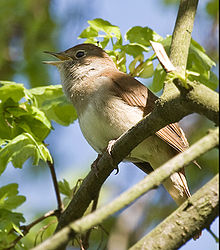'Twas on one April morning, I heard the small birds sing ...
 |
| Nightingale (Ruiseñor in Spanish) |
I haven't heard my nightingale at night though; according to Wikipedia, only unpaired males sing at night, in order to attract a mate.
Listen to his song here
The ruiseñor will be on his way soon, but Alcalá is a birder's paradise all year round. An ornithologist friend who has a house here writes in his blog, Birding Cadiz Province:
[Alcalá de los Gazules] has a good population of Lesser Kestrel and on spring evenings 60-70 or more may hawk over the village. Spotless Starlings are present and, although most of the swift are Common, there are a few Pallid Swift mixed in amongst them and Alpine Swift is also regular. Barn Owls nest in the church tower at the top of the hill. Around the ruined castle – a nesting site for many Lesser Kestrels –are the derelict mirador gardens from which you can get superb views across the Alcornocales. Blue Rock Thrush sometimes nest here. Birds of prey frequently overfly the village, particularly in spring and autumn. In addition to Lesser Kestrel I have recorded Griffon Vulture, Egyptian Vulture, Golden, Booted and Short-toed Eagles,Osprey, Red and Black Kite, Honey Buzzard, Common Buzzard, Montagu's, Hen and Marsh Harriers, Sparrowhawk, Goshawk, Kestrel, Hobby, Peregrine and Merlin. Bee-eaters are common on passage when both White and Black Stork may be seen.Visitors to Alcalá can't fail to spot the big birds; griffon vultures, cattle egrets, storks and various birds of prey are everywhere you look. But we have an impressive variety of small birds too, especially in the migration period. To the untrained eye, the "little brown jobs" that flit amongst the bushes could all be sparrows and the ones with forked tails could all be swallows. Only when you learn to distinguish their song and their flight patterns do you appreciate how much diversity there is: stonechat, goldfinch, siskin, serin, greenfinch and several varieties of warbler, bunting and lark are all common.
 |
| Bee-eater (abejaruco) |
Last week I spotted two bee-eaters, just up the road from our house. These are also migratory, and I haven't seen them in the village before. They might not be great singers; in flight they sound like a bunch of kids given a bag of referees' whistles to play with. But they are stunningly pretty, and they eat wasps as well as bees, removing the sting before eating them by repeatedly hitting the insect on a hard surface. They will also take lizards and frogs.
 |
| Goldfinch (jilguero) - the poor man's canary |
I'll take my birdsong au naturel, thanks all the same ...
Comments
Sadly I discovered there is some sort of virus among birds in our area, yesterday my husband found a dead bird with a piece of seed in it's mouth in our bird box.. Today a friend told me of a news story in the area she had read..
http://www.nelsonstar.com/opinion/letters/146205135.html
It's so strange not to hear the usual birdsongs in the